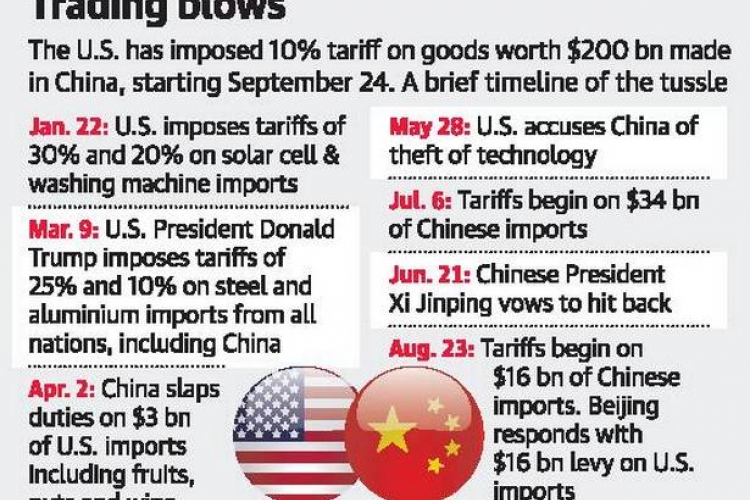US –CHINA TRADE WAR
IN NEWS
The trade rivalry between the U.S. and China escalated to an unprecedented level, with both countries announcing new tariffs on imports from each other.
The U.S. has announced 10% tariff on $200 billion of imports from China, whose retaliatory tariffs between 5% and 10% will apply to $60 billion of imports from the U.S. The new tariffs on both sides will go into effect on September 24.
TRADE WAR
Trade war is a situation where countries restricts each other’s’ trade by imposing tariff or quota on imports. Retaliatory steps by partner country intensifies the trade war. As a result, international trade comes down. Main purpose of import restriction is to protect domestic industries, promotion of local production and enhancement of employment.
Donald Trump’s Trade War
The US President Donald Trump in the recent past, announced a group of protectionist measures on trade front; aiming to reduce US trade deficit with other countries and thus to protect domestic industries and employment. Most of these measures disturbs the existing trade laws and relations that were globally configured after decades of multilateral discussions and agreements. Specifically, the tariff and other steps will damage the trade agreements under WTO.
A notable element of Trump’s new protectionist step is that they are imposed on the ground of national security. The advantage of security risk argument is that such a stand may make these measures difficult to be tackled under the present WTO framework.
REASON FOR THE US-CHINA TRADE RIFT
The Trump administration has accused China of using predatory tactics in a lawless drive to overtake America’s technological supremacy. US officials point to Beijing’s long-range development plan, “Made in China 2025,” which calls for creating powerful Chinese entities in such areas as information technology, robotics, aerospace equipment, electric vehicles and biopharmaceuticals.
Foreign business groups argue that “Made in China 2025” is unfairly forcing them to the sidelines in those industries. The Office of the US Trade Representative concluded after an investigation that China’s tactics range from requiring US and other foreign companies to hand over technology in return for access to the vast Chinese market to outright cyber-theft. The US also asserts that Beijing uses state money to buy American technology at prices unaffordable for private companies.
CHINA S REACTION TO THE TRADE WAR
China has no choice but to retaliate against new US trade tariffs. China has announced tariffs by up to 25% on 128 items imported from the US. China’s government also announced it was adding this round of tariffs to an existing complaint filed with the WTO in April shortly after Washington unveiled the threat to punish Beijing for its policies on intellectual property. Months of dialogue between the two economic superpowers, including in the WTO, appeared to have failed, with Trump warning just hours before the tariffs came into effect that Washington was ready to escalate the dispute with duties on hundreds of billions of dollars more in Chinese imports.
IMPACT ON INDIA
There is a lot of uncertainty with respect to how the ongoing retaliatory tariff impositions between the US and China. Capital flows will be affected but that’s not due to trade tensions.
The US Fed is in monetary policy tightening mode. A recent UNCTAD report says foreign direct investment has already slowed down. The rupee will weaken more on account of capital flows than the impact of trade problems.
WAY FORWARD
There is no question that economic growth and asset markets will be badly hurt by a full-blown trade war. The more important issue is the current global economic order is in danger of being dismantled, brick by brick. The ramifications will go far beyond trade—the impact on geopolitics, for instance, could be far more serious.
.


 IAS -2025 Prelims Combined Mains Batch - III Starts - 14-04-2024
IAS -2025 Prelims Combined Mains Batch - III Starts - 14-04-2024